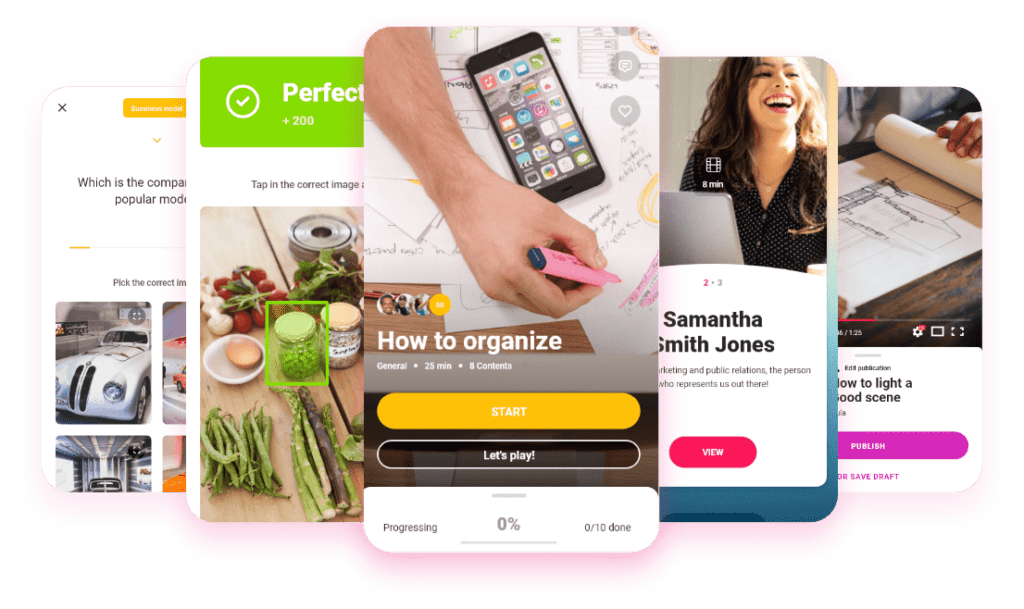Table of contents
ToggleEffective internal communications are one of the cornerstones of an organization’s success. Surprisingly, a staggering 80% of employees will prioritize a company’s commitment to transparent communications over enticing incentives, this highlights the vital role it plays in shaping workplace satisfaction and loyalty.
Acknowledging the transformative force of effective communications within your company, we’ve put together this post to provide you with invaluable insights. Dive into the best advice on crafting a robust strategy that not only empowers your employees but also propels your company to new heights of success.
Why internal communication matters: Unveiling its crucial role in business success
In addition to key external factors, the success of a company depends on the individual performance of its workforce. Providing them with the necessary tools, information, and support is paramount to cultivating motivation and engagement.
If done correctly, an internal communication strategy, can transform employees into valuable brand ambassadors. Employer branding is vital to attract and retain top talent, it builds trust and a work environment where workers feel valued and respected.
On the other hand, having open communication spaces, allow workers to share their thoughts and ideas, this drives innovation ultimately leading to the organization’s progress. It is definitely a win-win situation for everyone.
Moreover, communication promotes collaboration across departments, which is pivotal. Particularly for remote teams and frontline workers without desktop access.
According to Tech Report, providing timely information to employees can increase their productivity by an impressive 77%, creating a ripple effect of efficiency across the entire organization.
Aligning internal communication objectives with the corporate strategy
To craft a robust internal communication plan, it’s crucial to be conscious of the overarching corporate plan. This understanding lays the foundation for alignment and preparation. By understanding the company’s mission, vision, and values, which is the very essence of its identity, you can tailor your approach. Not only does this ensure the seamless execution of your plan, but it also fosters greater employee buy-in, fortifying their commitment to achieving corporate objectives.
Here, we reveal some of the objectives of an internal communication strategy:
Share valuable information about the company
One of the main objectives of internal communications is to share company information, this can be anything from the company’s performance and how they are reaching its targets, to corporate information about new products or services that are being launched or corporate documentation such as its brand book or standard operating procedures (SOP).
Sharing information consistently is highly beneficial for employees, it helps them stay aligned and promotes coherency across multiple departments and business units.
Train employees and provide tools for their job
Another objective is to train employees and deliver useful tools to help them better perform their job. Training your employees does not stop after onboarding, giving them support throughout their career fortifies their capabilities individually and as a team.
A good example of this, is how Shiseido, a recognized global Japanese cosmetics company, used gamification to train their global network spread in 120 different countries. Offering short interactive pills of information about their new line of makeup through a dedicated social game app, increased knowledge retention over 90%, empowering its employees. Read case study.
Optimize the workflow between different departments
Delivering internal information is essential for teams to work collaboratively, it optimizes the internal workflows and allows organizations to align its workforce towards its business objectives.
Promote your employer branding initiatives
Employer branding is how companies promote their own brand internally to employees. It is also used externally to hire new talent. Why is this important? Because it reinforces a sense of belonging, this translates to employee loyalty, lower absenteeism, and turnover.
Retaining talent is vital for the company’s bottom-line. According to Randstad, for organizations to remain productive and financially healthy they need to decrease employee churn rates because each lost employee can cost the company one third of their annual salary.
Onboarding of new employees
The first few months for a new employee are critical, how you plan out a clear onboarding process with training materials and tools to get to know the business and its products has a direct impact on their future performance and motivation. According to recent data, employees are three times more committed to the organization when they are provided with a good onboarding experience.
Onboarding of new employees
The first few months for a new employee are critical, how you plan out a clear onboarding process with training materials and tools to get to know the business and its products has a direct impact on their future performance and motivation. According to recent data, employees are three times more committed to the organization when they are provided with a good onboarding experience.
Provide a space where employees can share thoughts and ideas
Internal communications can become more powerful when there’s a two-way communication with its stakeholders. This means opening channels where employees can share thoughts and ideas that drive innovation. Some examples of channels include forums, chats, or surveys, with the latter helping HR professionals gather feedback and assessing employee satisfaction and enhancing a positive workplace.
Creating a positive workplace culture
Workplace culture is a core factor, making an initial audit of the workplace culture will help you find gaps and needs of your employees. As per a Great Place to Work, some questions that the culture audit team uses involve ¨people practices, policies, and other data related to how both HR and leadership alike work to build a strong culture¨. Having in mind this approach can help you question and organize your internal communication objectives and priorities.
Exploring styles of internal communications
Now that we’ve uncovered the benefits and objectives, it’s crucial to understand the various communication styles to kickstart the implementation of your own strategy.
Top-down communication
This style of communication refers to messages that are shared from top senior leadership all the way down the organizational structure. This usually involves important company announcements about strategic decisions made at the highest level.
Top-down communications are highly beneficial because they mitigate the risk of misinformation, promote transparency and clear information for all employees, and impact positively on the brand’s internal reputation.
Bottom-up communication
On the other hand, bottom-up information is delivered from lower-level managers and team members all the way up the company structure to senior leaders.
If done properly, leveraging this style of communication, can lead to many advantages for businesses. It encourages employees to further engage and contribute to the decision-making process, as well as creates a healthy work environment by implementing a two-way communication with team members.
Horizontal communication
This style of communication, also referred to lateral communication, involves the information flow between individual employees, teams and departments that are at the same level in the organization.
Horizontal communication is the most common style, and it is vital to improve productivity and help teams stay aligned with the company goals. Furthermore, it cultivates a culture of teamwork, boosts visibility, and ensures accountability.
Knowing the types of communication styles will help you segment properly all your internal communication efforts, use the appropriate channels, and create a targeted strategy that brings value to the company.
Taking this into account, let’s delve deeper on how to plan out an effective communication strategy to fuel employee motivation and skyrocket productivity.
Steps to create a successful internal communication plan
Before you start to craft your strategy, there are several pivotal factors that need to be considered, these will guide you to create the right corporate narrative to convey its vision and values, tailor messages, and find the perfect tools to deliver communications to segmented internal audiences.
1. Analyzing the current situation
Before crafting your internal communication plan, it’s essential to assess the current communication landscape within your organization. Evaluate existing channels, employee feedback mechanisms, and engagement levels to gain insights into what’s working well and where improvements are needed. This analysis sets the foundation for understanding the strengths and weaknesses of your current communication approach, guiding subsequent planning efforts effectively.
2. Defining your desired outcomes
Clearly defining your desired outcomes is crucial for aligning your internal communication efforts with your organizational goals. Identify specific objectives you aim to achieve through improved communication, whether it’s enhancing employee engagement, fostering a company culture, or informing teams about new products and services. Setting clear and measurable goals provides direction and focus for your communication strategy, ensuring that efforts are oriented towards results.
3. Identifying audience segments
Defining the target audience is decisive, as there may be several distinct groups to consider, including Gen X, Millennials, and Gen Z, regardless of company size. In fact, Generation Z already comprises 20% of the global workforce, this segment may require unique training and information strategies that are different to other generations considering that they are more digitally savvy.
4. Communication channels
Choosing the right communication channels will have a positive impact on your results. Leveraging multiple channels ensures message reach and resonance across diverse teams and communication preferences. By carefully assessing the unique needs and dynamics of the organization, choosing the right mix of communication channels can enhance engagement, foster transparency, and facilitate seamless information flow throughout the company.
5. Create an internal communication matrix
An internal communication matrix ensures organization, oversight of projects, and consistency across channels.
Identify key stakeholders and departments involved, including executives, managers, and employees. Also, you should determine types of information to communicate, categorizing by frequency, urgency, and audience.
Moreover, establish clear channels like email newsletters or team meetings based on message nature and audience preferences. Define roles and responsibilities for each department, ensuring accountability.
Finally, regularly review and update the matrix to adapt to organizational needs and feedback. This structured framework fosters transparency, collaboration, and alignment across teams, driving success
6. Measuring progress and results
Measuring the effectiveness of your internal communication efforts is crucial for continuous improvement and demonstrating the impact of your strategies. Implement metrics and feedback mechanisms to track key performance indicators such as employee engagement, message reach, or feedback response rates.
Regularly evaluate progress against predefined objectives, analyze results, and adjust as needed to optimize your communication plan for success.
5 Internal communication trends and ideas
Having examined factors and steps for crafting an internal communication strategy, as well as exploring the creation of a solid communication matrix to stay on track, we now offer five effective ideas aligned with current social trends.
Knowledge acquisition through microlearning and microcontent
In today’s fast-paced work environment, traditional learning methods may not always suffice. Microlearning and microcontent offer bite-sized, easily digestible information that cater to the modern learner’s preferences.
Leveraging these dynamic learning formats, organizations can facilitate continuous learning and skill development among employees. Whether it’s audios, infographics, short videos, or quizzes, microlearning enables knowledge acquisition on the go, allowing employees to access relevant information precisely when they need it most.
Level up engagement through inspiring gamification actions
Gamification injects fun and excitement into mundane tasks, motivating employees to engage more actively with work-related activities.
Incorporating interactive games such as challenges, rewards, and leaderboards, organizations can create a more engaging work environment.
Gamification not only boosts employee morale and motivation but also fosters healthy competition among teams. From training programs to performance management, gamification offers endless possibilities.
Supercharge collaboration through social tools
In today’s fast-paced workplace, instant messaging, newsfeeds, and push notifications are pivotal for fostering collaboration and driving organizational success.
Instant messaging apps allow employees to communicate in real-time, facilitating quick exchanges of information and ideas regardless of their physical location.
Newsfeeds keep employees updated on company news, events, and updates, ensuring everyone stays informed and in sync. Push notifications provide timely reminders and alerts, keeping employees committed and on track with important tasks and deadlines.
By leveraging these internal communication tools, organizations can break down communication barriers, promote cross-functional collaboration, and harness the collective knowledge and creativity of their workforce, ultimately driving innovation and achieving business goals.
Amplify your employee’s voices through internal surveys
Employee feedback is invaluable for understanding their needs, preferences, and concerns, and internal surveys provide a structured way to gather this feedback.
Conducting regular internal surveys, organizations can increase employee satisfaction, identify areas for improvement, and make data-driven decisions to enhance the employee experience. Whether it’s measuring engagement, soliciting feedback on company policies, or evaluating the effectiveness of communication initiatives, internal surveys empower employees to voice their opinions and contribute to organizational growth.
Seamlessly integrate a knowledgebase for instant access
In today’s knowledge-driven economy, easy access to information is paramount for employee productivity and efficiency. A knowledgebase serves as a centralized repository of information, documents, and resources that employees can access whenever they need assistance or information.
Seamlessly integrating a knowledgebase into the organization’s infrastructure, employees can quickly find answers to their questions, troubleshoot issues, and access relevant resources to perform their jobs effectively. From training materials to company policies and best practices, a well-organized knowledgebase streamlines information retrieval, fosters self-service, and empowers employees to succeed in their roles.
With a grasp of the essential steps and inspiring ideas for crafting a successful internal communication strategy, you’re ready to dive into planning!
With a well-defined strategy in hand, leverage isEazy Engage to execute your plan and unlock optimal outcomes. Our app is tailored to enhance learning with bite-sized microcontent, empower users with essential knowledge, boost engagement via gamification, and foster seamless connectivity through social networking features—all conveniently accessible in one mobile app, anytime, anywhere. Curious to learn more? Request a demo with one of our e-learning experts today















